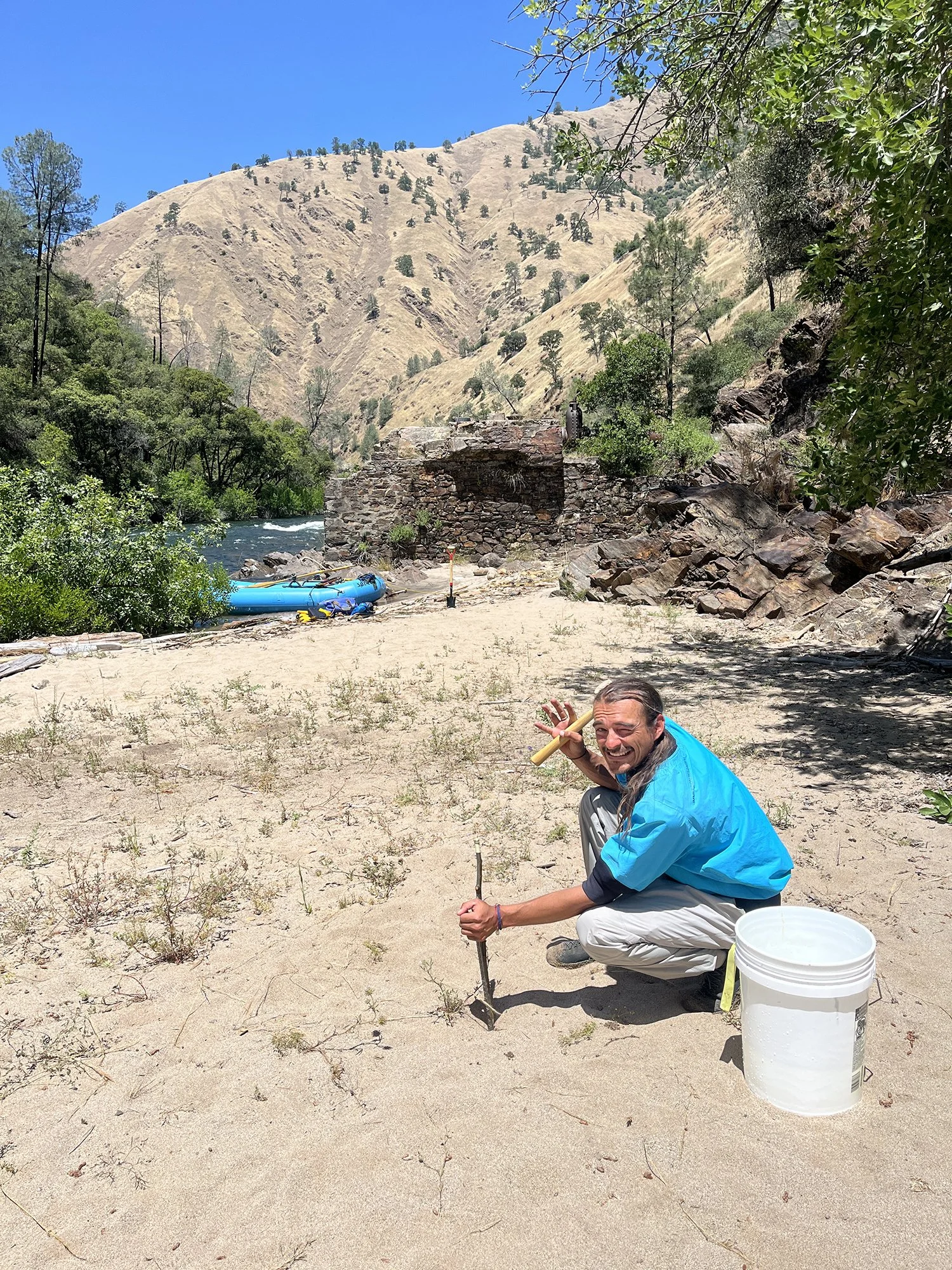Rafting for Restoration: Willow Planting Along the Wild and Scenic Tuolumne
On a sunny June morning, a small rafting team set off into the Tuolumne River’s turbulent waters for a day of riverside restoration. Margaret (TRT Restoration Specialist), Bryn (Sierra Nevada Alliance Partnership Restoration Specialist), and Zach (Sierra Mac River Trips Guide) packed up a sizable bundle of willow cuttings and gear, donned wetsuits, and set off.
The team paddled vigorously for eighteen miles through churning waters and challenging rapids. Margaret shared “the experience is always a humbling reminder of the sheer force of whitewater”; on the day of their journey, flows were as high as 8,000 cubic feet/second.
Eventually, the team approached their planting spot for the day—a section of the river that lost a significant amount of riparian plant life after the Rim Fire tore through this region in 2013. “These sites are experiencing erosion—sediment washing away that leads to less vegetation,” Bryn explained. “Planting willows helps catch sediment so sandbars can thrive and other plants can grow there. Without human stewardship, the effects of the Rim Fire will continue to compound.
These sites are nearly impossible to reach on foot for restoration, so TRT relies on the rafting community to access these areas. “We chose these specific places to plant based on the river guides’ recommendations. Because they are on the Wild and Scenic stretch of the Tuolumne almost every day of the summer, they have the best knowledge about which areas are most impacted by erosion,” added Margaret.
As the river coursed beside them, Margaret and Bryn planted twenty willow cuttings with Zach’s support. This process involves driving unrooted willow branches with careful force deep into riverbank soils.
Over the next seasons, the willow will adjust, take root, and eventually grow into adult trees— their roots preventing erosion, their dense foliage providing shade, shelter, and habitat for myriad species from willow-loving birds such as yellow-breasted chats and spotted towhees to whitewater rafters resting and picnicking on the shore.
Among other things, ensuring the river bed stays connected to the riparian forest beside it creates fire resilient lands. When the river banks have enough foliage to encourage sediment accumulation a flexible riparian ecosystem emerges: one with ample sand bars that help the transition between erosive rapids and the forest itself. Healthy riparian plant communities ensure that water can slow and percolate through the forested lands, recharging groundwater and moistening dry soils–another fire safe feature of a healthy riparian edge.
Driving willow stakes into a compacted riverbank is hard work; after twenty were planted, time was up, and the whole crew had to raft onward. Feeling committed to the ecological importance of this work, Zach offered to personally plant the remaining thirteen trees on a weekend return trip.
Margaret and Bryn affirmed how commonplace this level of commitment and collaboration is between the rafting community and environmental stewards. Through various partnerships with ARTA, All Outdoors, OARS, and Sierra Mac, TRT connects habitats throughout the upper Tuolumne—an otherwise inaccessible riparian corridor.
“As I have started to work with people from Tuolumne County, it is clear how much they care about protecting their forests and rivers,” Margaret said. “I hope our projects are a source of inspiration to the community, and also a reassurance that there are groups working together to build climate resilience for the Tuolumne watershed and the surrounding region.”
Bryn backed this up by noticing the interconnection between economic and ecological values. “People who love outdoor sports generally get the message that it’s good to care about the environment in the abstract “be-a-good-person” way, she noted. “For recreation companies this connection runs deeper—they also realize that the health of the environment impacts their day-to-day work and livelihood.”
The connections between conservation and recreation are, in fact, an integral part of TRT’s foundational story.
Marty McDonnell, one of TRT’s founding board members and owner of Sierra Mac River Trips, has made the river his life. Alongside other early members of TRT, Marty fought to protect the Tuolumne River from three proposed dams by winning Wild and Scenic status for the river in 1984. Today, he continues to advocate for accessible routes to put-ins and boat launches along the river, such as Meral’s Pool, where Bryn, Margaret, and Zach launched their raft that day.
Alongside bundles of willow, planting tools, and paddles, access to the river—shared from one generation to the next—was another tool packed along on that day’s journey. All of these past moments of advocacy act as building blocks for the ecological stewardship of subsequent generations.
Likewise, as the years pass what looks like a collection of small bare branches today will grow into a riparian thicket of willows filling the riverside with shade, stabilizing soil, and creating rich habitat into the future.
Through Margaret, Bryn, and Zach’s work, and the example of TRT founders before them, we see that climate resiliency emerges when people work intergenerationally in coalition with other species, forces, and places—like willow, water, rafters, and ecologists coming together along the banks of the Wild and Scenic Tuolumne River.





